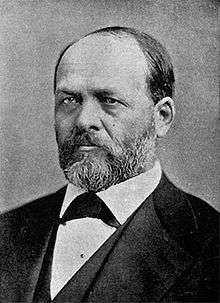Charles B. Farwell
| Charles B. Farwell | |
|---|---|
 | |
| United States Senator from Illinois | |
|
In office January 19, 1887 – March 3, 1891 | |
| Preceded by | John A. Logan |
| Succeeded by | John M. Palmer |
| Member of the U.S. House of Representatives from Illinois's 1st district | |
|
In office March 4, 1871 – March 3, 1873 | |
| Preceded by | Norman B. Judd |
| Succeeded by | John Blake Rice |
| Member of the U.S. House of Representatives from Illinois's 3rd district | |
|
In office March 4, 1873 – May 6, 1876 | |
| Preceded by | Horatio C. Burchard |
| Succeeded by | John V. Le Moyne |
|
In office March 4, 1881 – March 3, 1883 | |
| Preceded by | Hiram Barber, Jr. |
| Succeeded by | George R. Davis |
| Member of the Indiana House of Representatives | |
| Personal details | |
| Born |
Charles Benjamin Farwell July 1, 1823 Painted Post, New York |
| Died |
September 23, 1903 (aged 80) Lake Forest, Illinois |
| Nationality | American |
| Political party | Republican |
| Spouse(s) | Mary Eveline Smith |
| Alma mater | Elmira Academy |
| Signature |
|
Charles Benjamin Farwell (July 1, 1823 – September 23, 1903) was a U.S. Representative and Senator from Illinois.
Life and career
Farwell was born in Painted Post, New York and attended Elmira Academy before moving to Illinois in 1838. He first tried his hand at surveying and farming before moving to Chicago in 1844, when he went into banking. From 1853-1861, he served as the Clerk of Cook County. Farwell was "one of the principal builders in [Chicago's] business district" in the last quarter of the 19th century.[1] That he was able to amass a sizeable fortune can be proven by the fact that he owned one of the finest mansions on Chicago's North Side.[2]
Elected to the U.S. House of Representatives four times beginning in 1870, winning his first election to the House by a healthy margin over Chicago's "Long" John Wentworth (by some 5700 votes). Farwell went on to serve in the House of Representatives in the 42nd, 43rd, 44th and 47th Congresses . In 1876 the Democrat-controlled Congress accepted John V. Le Moyne's challenge to Farwell's election and removed Farwell from office; Farwell declined to run again at the time of the general election later on in 1876. In 1880, he was elected to another term in Congress (the 47th Congress). Upon the death of John A. Logan in 1887, Farwell was elected to serve out Logan's term in the U.S. Senate, but refused to run for re-election to a full term.[3] Significantly, in Farwell's first term as Senator, he supported the introduction of an amendment to the U.S. Constitution that would have granted women's suffrage rights (the right to vote) - simultaneously a landmark achievement of and a setback in the long struggle for voting rights for women that would not be overcome until the adoption of the Nineteenth Amendment to the United States Constitution in 1920.[4]
In 1876, at his wife's urging, Farwell underwrote the construction of College Hall, North Hall and a gymnasium at Lake Forest College. The couple also donated additional land to the college which had been struggling since the end of the Civil War.[5] Part of their philanthropy was to ensure a co-ed liberal arts college near home for their daughter, Anna, who graduated from Lake Forest College in 1880. Anna later married the composer Reginald de Koven, and became a successful socialite, novelist and amateur historian. His daughter Rose was married to Hobart Chatfield-Taylor.[6]
References
- ↑ Steffes, Patrick (31 December 2011). "Bertrand Goldberg in Tower Town Part 1: Bertrand Goldberg's Commune". http://forgottenchicago.com/. Forgotten Chicago. Retrieved 16 May 2014. External link in
|website=(help) - ↑ "Charles B. Farwell mansion, 120 E. Pearson St., Chicago, IL (1905)". http://www.memory.loc.gov. Library of Congress, courtesy Chicago History Museum. 1905. Retrieved 16 May 2014. External link in
|website=(help) - ↑ "FARWELL, Charles Benjamin". http://history.house.gov/. Offices of the Historian, Art & Archives, U.S. House of Representatives. n.d. Retrieved 16 May 2014. External link in
|website=(help) - ↑ Steffes, Patrick (31 December 2011). "Bertrand Goldberg in Tower Town Part 1: Bertrand Goldberg's Commune". http://forgottenchicago.com/. Forgotten Chicago. Retrieved 16 May 2014. External link in
|website=(help) - ↑ Ebner, Michael H. (Summer 2007), "North Shore Town and Gown", Chicago History, p. 6
- ↑ Bluff's Edge Estate Archived June 6, 2010, at the Wayback Machine.
External links
- United States Congress. "Charles B. Farwell (id: F000037)". Biographical Directory of the United States Congress.
| United States House of Representatives | ||
|---|---|---|
| Preceded by Norman B. Judd |
Member of the U.S. House of Representatives from Illinois's 1st congressional district 1871–1873 |
Succeeded by John Blake Rice |
| Preceded by Horatio C. Burchard |
Member of the U.S. House of Representatives from Illinois's 3rd congressional district 1873–1876 |
Succeeded by John V. Le Moyne |
| Preceded by Hiram Barber, Jr. |
Member of the U.S. House of Representatives from Illinois's 3rd congressional district 1881–1883 |
Succeeded by George R. Davis |
| United States Senate | ||
| Preceded by John A. Logan |
U.S. Senator (Class 3) from Illinois 1887–1891 Served alongside: Shelby M. Cullom |
Succeeded by John M. Palmer |
